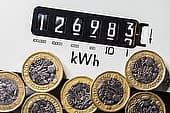Home > Energy > News > E.ON expect bills to fall when energy price cap is reviewed
E.ON expect bills to fall when energy price cap is reviewed
Major energy supplier suggests standard tariff bills could fall by more than £70 in the autumn following the next review of the energy price cap.
Wholesale costs of gas and electricity have fallen during 2019, and this should lead to a lower cap for customers on standard tariffs.
Ofgem will formally confirm the level of the price cap in August following their second review of the cap.
In their statement, however, E.ON point out that wholesale costs are only one factor in the level of the cap, tempering consumer expectations about their lower energy bills.

Why might the cap fall?
Wholesale costs impact the level of the price cap as set by Ofgem, and wholesale costs have fallen so far this year.
While E.ON concede there has been a recent spike in costs, the general trend over the last few months has been a downward one.
Plentiful energy supplies and milder weather conditions have led to a market that's working better for suppliers, and they will be expected to pass on those savings to customers.
That said, the energy price cap isn't only based on wholesale prices. It is calculated by looking at the costs of supplying energy, and this is impacted by policy and network costs among other elements.
Background to price cap
The next alteration to the energy price cap which will be announced in August will be the third level set by Ofgem since the cap was first confirmed in November 2018.
At the time, the cap was set at £1,137 per year, and this came into force in January 2019. It was announced a month later that the cap would rise to £1,254 in April.
Energy suppliers responded by raising their standard variable tariffs to the maximum allowed, with both major and challenger suppliers announcing price rises in February and March.
Centrica, the owner of British Gas, also confirmed profits were being hit by the energy price cap, and that this would impact cashflow throughout 2019.
If the cap is lowered as expected, this may cause further unrest among suppliers. Centrica already sought a judicial review when the cap was first introduced as they believed it had been calculated unfairly by Ofgem.
There is certainly a lag when it comes to implementation of the cap. Once the change is announced in August, it won't come into force until October - just when wholesale prices will start to rise again for suppliers.
Is the price cap working?
Supporters of the energy price cap will point to the fact that it's expected to fall in autumn as confirmation that it's working.
However, the price cap itself isn't a cap on the total amount paid by customers. It is simply a cap on the amount customers are charged for each unit of energy they use.
This has led to some confusion for customers who pay more per year depending on their usage, rather than the amount of their bill being capped.
The price cap isn't intended to be a long-term solution to the problem of high energy bills for customers and is being used to cushion the blow as the smart meter rollout and other energy policies add to bills.
Ofgem have previously said the cap will remain in force until at least 2020 with the possibility to extend it as far as 2023 if they deem it necessary.
Compare energy deals from dozens of different suppliers using the free Choose comparison tool.
Get insider tips and the latest offers in our newsletter

We are independent of all of the products and services we compare.

We order our comparison tables by price or feature and never by referral revenue.

We donate at least 5% of our profits to charity, and we have a climate positive workforce.
Latest News

02 January 2024
Energy prices increase by 5%
23 November 2023
Energy price cap to rise 5% in January 2024
24 October 2023
Energy companies must do more to support customersGet insider tips and the latest offers in our newsletter


